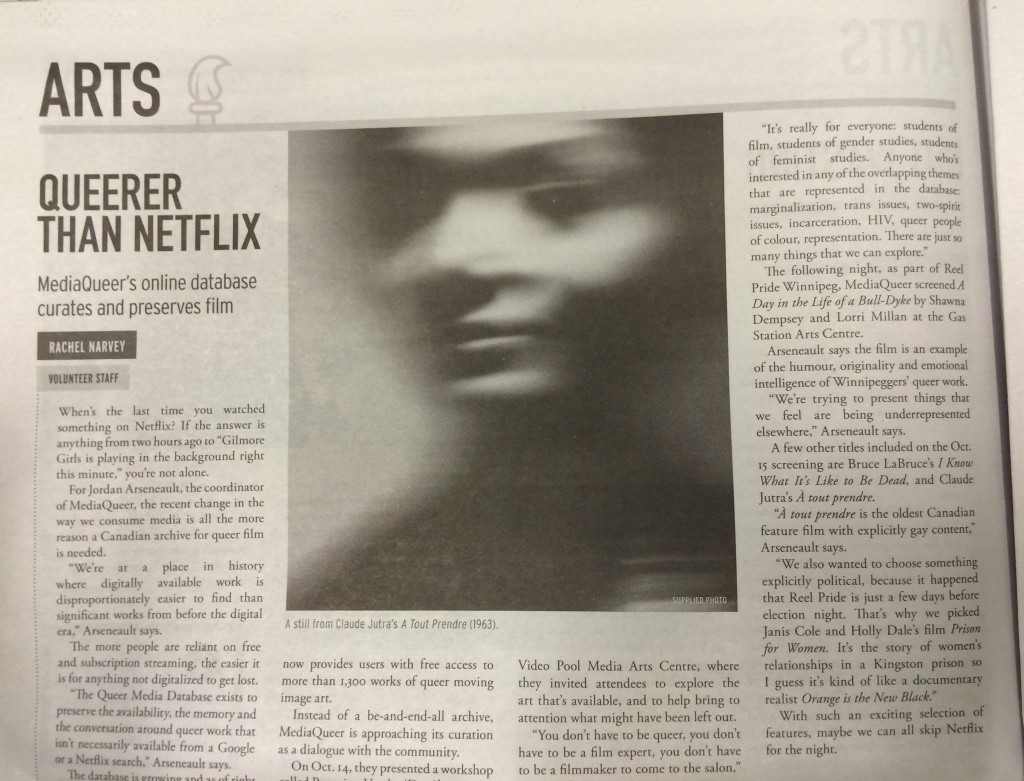Bums in Seats: Queer Media Database of Canada/Québec
The lights dim for the second of two screenings titled Matraques, a special event curated and organized by the Queer Media Database of Canada/Québec in collaboration with the queer film festival Image+Nation. The two-part screening is composed of twenty-one vignettes, each a short film or extract about the history of literal and metaphorical policing of queers in Canada. As the screenings end and the Q&A session starts, two things become evident. One: many people in the room know each other and others are being readily introduced, which makes knowledge of Canada’s queer history emerge out of the realm of shared collective memory, intensifying the already deeply communal nature of the event. Secondly, the bodies in the seats range from undergrads to seasoned film enthusiasts. Witnesses connect and respond to the programming on a visceral level, which for the younger people in the crowd enhances the immediacy of this history as represented in films that otherwise might have come across as demagogical or didactic. Judging by how no one feels like leaving Concordia University’s Cinema de Sève long after the films have finished, the screening is a resounding success.
A couple of days before the screening, I met up with Dr. Thomas Waugh and Jordan Arseneault. Prof. Waugh is Research Chair in Sexual Representation and Documentary Film at Concordia University’s Mel Hoppenheim School of Cinema and president of the Queer Media Database Canada-Québec. Waugh’s books include the anthologies The Perils of Pedagogy: The Works of John Greyson (with Brenda Longfellow and Scott MacKenzie, 2013); the collections The Fruit Machine: Twenty Years of Writings on Queer Cinema (2000) and The Right to Play Oneself: Looking back on Documentary Film (2011); the monographs Hard to Imagine: Gay Male Eroticism in Photography and Film from their Beginnings to Stonewall (1996), The Romance of Transgression in Canada: Sexualities, Nations, Moving Images (2006), Montreal Main (2010). He is also co-editor of the Queer Film Classics book series. Arseneault is the coordinator of the Queer Media Database Canada-Québec, as well as a drag performer, social artist, writer, meeting facilitator, translator and former editor of 2Bmag, Québec’s only English LGBTTQ monthly magazine.
According to the website, the purpose of the Queer Media Database of Canada/Québec is to “is to maintain a dynamic and interactive online catalogue of LGBTQ (lesbian, gay, bisexual, transgender, and queer) Canadian film, video and digital works, their makers, and related institutions.
How did the project come to be?
TW: There is a historic basis for the Media Queer Database. 20 years ago, when I started developing an encyclopedic project on Canadian queer moving image media, I saw and documented everything I could, thousands of short and long works. This documentation ended up in print form in my 2006 book The Romance of Transgression in Canada as an appendix to the main critical and analytic body of work. There are about 350 institutions and individuals embedded in the individual works that were catalogued and described. That print database festered and within five or six years we decided to bring it to life as a kind of living digital archive, using a Wiki model that would be maintained over time. My job is to supervise Jordan and other people working with the project, as well as guide the advisory board and push the project along. I try to empty my brain of data.
What do you mean by “Wiki model?” Does taking the online encyclopedia as a model imply a collaborative, open-source aspect for the archive?
JA: Copyright-wise, we decided to make it creative commons, which is different than a lot of academic material. This is a part of our mandate. There is also a submission form on the website. In other words, people can’t live-edit like they do on Wikipedia, but we do regular updates based on the submissions people give us. As the coordinator of the project, I periodically take the submissions that people have made, look at who we need to biographize, and then enter their filmographies, translate them, and so on.
Is there a lack of attention paid to Canadian queer cinema that this project is trying to address?
TW: Absolutely. Canadian work, especially in French, tends to become invisible in the global market. This is why we are committed to maintaining access to and visibility of these works. For this reason, the second phase of the project, once the website was up and running and our funds secured, became about programming. The Sunday event, Matraques, will be our fifth program of short and long films screened in the festival context in Canada. We are going international in 2016, with programs in India, France and Italy.
How is the project funded?
TW: We get funding from Concordia University, Canada Council, Heritage Canada and SSHRC. We also have partnerships with organizations across Canada who contribute moral support, facilities and some money, mainly in the form of accommodations and venues.
How has applying to these institutions and being helped by them verbalized the project?
TW: That is a very clever, Canadian question. Canadian culture and education are very much shaped by grant applications and criteria that everyone is scrambling to meet.
JA: We have been extraordinarily blessed with understanding on the part of these juries. People seem to get it. We applied for project funding that emphasized the national scope, research creation, public access to archival works… These are some of the trends we’ve tapped into. On the other hand, we haven’t been successful with one provincial funder who couldn’t conceive why we weren’t also streaming films. For them, a website hosting descriptions of artists and films did not really mean that much. Having said that, and having done the grant writing on the project since 2013, I find that there has been a very nice wave of understanding about the inherent value of having open-source material available on historic works. The AIDS Activist History Project, which is run by Alexis Stockwell at Carlton University and which collects oral history, interviews and names of activists and artists, has been similarly successful in that people understand how valuable primary source materials are.
TW: Streaming the films would also be great, but we can’t deal with the legality and materiality of rights ownership. Not only is it counter to our philosophy of copyleft and access, but it would also be a full-time industrial activity to maintain rights for 3,000 works. In fact, we want to support the distributors, exhibitors and rights owners who are doing their best to provide access to these works.
What are the project’s other institutional ties across Concordia? Prof. Waugh, you are a FIlm Studies professor at Mel Hoppenheim School of Cinema, which also runs the Moving Image Resource Center here at Concordia.
TW: We are friends with them all. My primary unit is obviously the Mel Hoppenheim School of Cinema, that’s our nerve center in a way. However, it might be bodies that matter rather than institutions. This would not be happening if it wasn’t for individual people’s passions and obsessions.
We are sitting in Concordia’s Fine Arts PhD Study Space here in the Fabourg Building in downtown Montreal, where the office for the project is located. How does one go about acquiring a space like this? How does it help you achieve your goals?
JA: We had to do an application to the Faculty of Fine Arts, which includes conversations about outcomes, partner grants and byproducts, including how many student employees there are. There is a strong pedagogical component to the project, the training and mentoring of undergraduate and graduate students involved in the project either as interns or employees. That was a requirement for obtaining the space. In that sense, the project is part of the larger Fine Arts pedagogical operation. This space is sort of weird, with all the VHS cassettes and lots of cardboard boxes. There is some technology here, but we don’t really use that stuff (laughs).
JA: When I need to transfer what we’ve received from a filmmaker on beta to MiniDV to DVD, I have to go to one of our partner organizations. At best, we could hobble together a VHS-to-DVD [converter]. In other words, there could be more technical equipment here, but we are happy to have obtained this space as a place for the project to legally have an address. In a way, the materiality of this space reflects the obsolescence of a lot of material and technology we deal with: from festival catalogues to films on formats ranging from tape to DVD.
Within the next two years, what began as a distant pipe dream for many of the organizations we work with, making the films legally streamable online, will finally be a reality. This is maybe forty percent of the materials we are talking and writing about.
TW: We will host direct links to these works. We will remain necessary because none of the distributors are queer per se. We need to claim kinship with all these objects and people; otherwise, they remain unidentified. The distributors, out of politics of impartiality, do not play the game of naming that is essential for us. The presumption of community and kinship through naming is at the core of the project.
Moreover, I like the concept of materiality, as it segues into corporeality, and the audience’s bums in seats. They are the ultimate matter of this project to me, so it is very exciting to meet them all across the country and see them discovering these works.
The knowledge that emerges out of the database is embodied in the screening events that seem central to the project. Could you tell me more about these events?
JA: We will have organized nine such events across Canada by the end of the inaugural year. In Toronto, for example, we were in the Buddies in Bad Times community theatre in the Village, where, even though we presented with the Inside Out film festival, we screened during Pride rather than compete for attention in the festival context. The event was sponsored by the Canadian Lesbian and Gay Archives, and it was in dialogue with so many other events. In Vancouver, on the other hand, we were in the very chic Vancity Theatre and that was a more traditional cinema experience, with all the trappings of a film festival.
How do you envision these events? What kind of audience engagement are you trying to create, and what kind of “look and feel” do you think is the most conducive to the project?
JA: We do two different things. In Winnipeg, we were showing a film called Prison for Women by Janis Cole and Holly Dale, as well as Claude Jutra’s À tout prendre, a very crypto-gay film. However, I did a salon with local filmmakers, curators and their local distributer called Videopool the day before in order to get input about what we are missing in the catalogue. Before coming to this project, the screenings I’ve attended and organized were about hanging a sheet and acquiring enough folding chairs in order to watch a film that someone physically brought from the Berlin festival, for example. Film festivals are important for the legitimization of queer cinema, and so is the sense of community. That is why I love that sort of artisanal, communal, “pink popcorn” practice of spectatorship where people don’t mind if they don’t have the perfect line of sight. So in Winnipeg we got to do both a venue screening and a salon. We are doing another salon this coming January at Videofag, a queer space in Toronto where we will again be talking about what is missing from the archive and what our next foray of research should be.
What are the requirements for being added to the database?
JA: To be included, the work needs to have been shown twice publicly. Otherwise, the profusion of eligible works would be astronomical. We are still considering self-published work. For example, with web-based work, if it has been seen 1,300 times, that might count as a public showing. Because, let’s be clear, in the Canadian art realm, a majorly distributed work might have been shown fourteen times. It’s all still very indie.
What links everything from the latest Xavier Dolan film to a lesbian stop-motion animation about bunnies is the political significance of self-describing as queer and ascribing queerness to an art object. I wonder when that might be made obsolete. However, a part of me thinks that structural homophobia and misogyny will continue be present to such a degree that an explicit queer lens on the moving image will always be useful.



